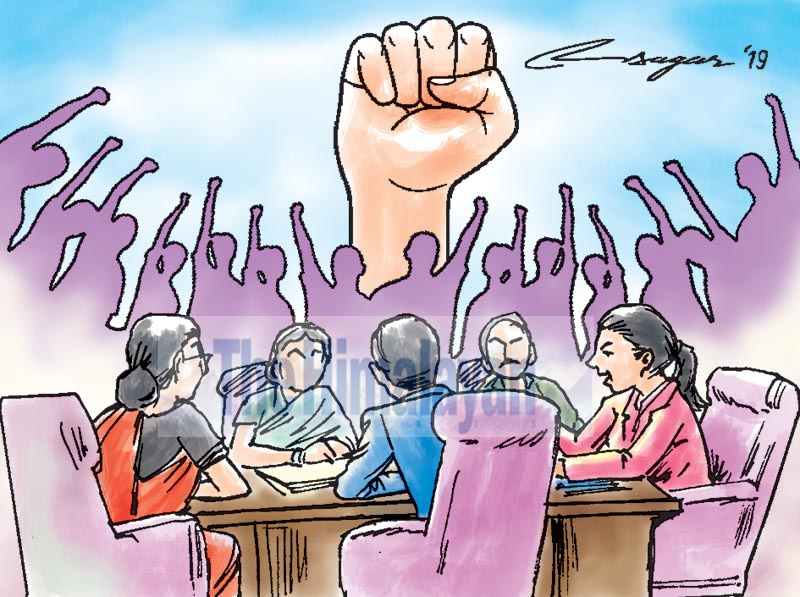End impunity: Don’t make mockery of HR
Human rights and good governance are two sides of the same coin. They are inter-related and inter-connected. The concept of human rights is incomplete without good governance though the idea of good governance is a new one
Nepal, compared to other Asian countries, has been a significant signatory of several international conventions regarding human rights and humanitarian law. These international conventions have openly denounced impunity. Nepal, as a state party to these conventions, should implement the legal and constitutional measures to end impunity. It is a matter of regret that impunity has not been fully addressed till now. For instance, a teenager, Nirmala Pant, was raped and murdered, but the perpetrators have yet to be arrested and punished even months after the incident took place. Many others perpetrators of human rights abuse have not been punished, and they are challenging the rule of law in the state.
Amnesty International (AI), in its report of 2017/18, mentions that a climate of impunity has persisted in the country. According to its report, there are eight areas of human rights violations in the country. They include transitional justice, enforced disappearance, impunity, abuse by police personnel and armed groups, use of children as soldiers, torture and other forms of ill-treatment, and violence against women. The report further states: “Impunity continued for perpetrators of human rights abuses during the conflict - no case had been tried before a civilian court and survivors of sexual violence reported that police refused to file their complaints.”
On torture, the report states that national laws providing safeguards against torture fell short of international standard, and were hardly implemented given that more than 1,300 new cases of torture have been recorded since 2006.
Very recently, the present chair of National Human Rights Concern Nepal (NHRCN), said that in its probe of an encounter with the police, in which two alleged abductors of a child were killed in a forest in Bhaktapur, it needed further investigation.
First, why did the police need to fire 17 bullets at the two Tamang boys – the alleged abductors? Secondly, how did the police know that the child, Nishan Khadka, who was abducted for ransom and killed, was buried at a certain location? Could it be that the two Tamang boys were detained by the police, and they revealed the location during interrogation? The police said there was two-way firing. But no cartridges of bullets fired at the police were found at the site.
Incidents of police encounters have been on the rise in the country. Two gangsters – Chari and Ghainte – having connections with the political parties were shot dead in police encounters. A thorough investigation of such cases needs to be carried out by the government to see if the encounters were indeed genuine.
The NHRC chair has also mentioned that during the Tarai movement, shots were fired at three children who were not part of the agitation: A boy who was looking out of a window at home; a child sleeping on his mother’ lap; and a teenager observing the agitation. He has also asserted that they were not part of the agitation. They were shot either on the chest or back when the police are authorised to shoot only below the knees. Bullets were also fired when there was no need to shoot.
The government had constituted two commissions led by former Supreme Court Justice Girish Chandra Lal and judge Ali Akbar Mikrani to investigate the cases. Reports of both the commissions have not been made public. There’s no justification for not making such reports public in a democratic country.
Every day, there are reports of rape in the media from all corners of the country, but nobody seems to pay any attention to it. There seems to be confusion about what rape really stands for.
Human rights and good governance are two sides of the same coin. They are inter-related and inter-connected. The concept of human rights is incomplete without good governance though the idea of good governance is a new one. Good governance sounds simple, but its implementation is crucial for the success of democracy.
Transitional justice is in jeopardy. Take the example of the recently formed committee, headed by former chief justice Om Prakash Mishra, to recommend names of the members of the Truth and Reconciliation Commission (TRC) and Commission on the Investigation of Enforced Disappeared Persons (CIEDP). The government has drawn flak for not consulting and taking consent of the victims’ representatives and human rights activists in the formation of the committee. Besides Mishra, the committee has one member each from the Nepali Congress, the former CPN-UML and the CPN-Maoist Centre, as in the 2015 commission. The government has not learned from its past mistake. Again, if party activists are to be appointed in these commissions, the result will be the same.
The newly-appointed officials in the two commissions will not be able to finish 63,000 cases in the TRC and about 3,000 cases in the CIEDP within their tenure of two years.
The government should, therefore, amend the TRC Act according to the 2015 Supreme Court ruling and international standard, and then appoint the officials. There should not be any attempt to appoint party cadres to the two commissions. They must at least try to heal the wounds of the conflict victims who have been suffering for more than one decade. They have not received any reparation, either. This is also injustice.






